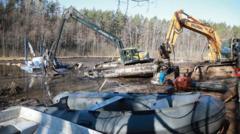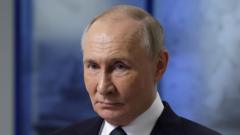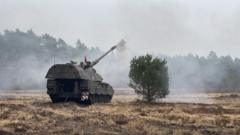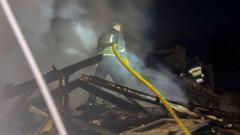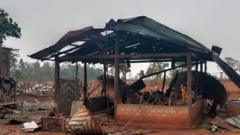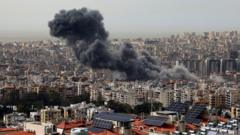Despite a recent ceasefire agreement between Ukraine and Russia, drone makers express concerns regarding future strikes on energy assets and continued military development.
**Concerns Grow Among Ukrainian Drone Engineers Post-Ceasefire Agreement**
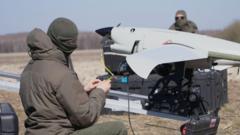
**Concerns Grow Among Ukrainian Drone Engineers Post-Ceasefire Agreement**
Ukrainian drone manufacturers remain skeptical about the durability of a new ceasefire designed to halt energy infrastructure attacks.
At a covert testing facility in Ukraine, engineers are actively working on their latest long-range drone, the Raybird. Designed for extended flights, the Raybird resembles a small aircraft and is engineered to be launched like an arrow from a crossbow. With the ability to fly for over 20 hours, this drone can reach targets far deeper into enemy territories, including Russian oil refineries and fuel depots.
This technological advancement comes amidst a fragile ceasefire arrangement recently brokered with the United States, aiming to halt mutual strikes on energy resources between Russia and Ukraine. While both nations have pledged to a limited maritime ceasefire in the Black Sea, doubts linger over Russia's commitment to uphold these agreements.
Oleksiy, an engineer from the Skyeton company responsible for developing the Raybird, voices skepticism about Russia's compliance. "They often strike first and then demand we restrain ourselves," he remarked, expressing a belief that conflict might continue despite officially declared pauses.
Additionally, the ongoing drone attacks by Ukraine have significantly impacted Russian oil output, estimated to have decreased by around 10% following drone strikes on key facilities. The pain of these attacks has been evident, as evidenced by Russia's recent extension on banning petroleum exports.
Ukraine's arsenal of long-range drones is expanding rapidly under the leadership of President Volodymyr Zelensky, who recently announced innovations that include drone technology capable of hitting targets over 3,000 kilometers away, potentially even as far as Siberia. With these advancements also come newly developed turbojet-powered "missile-drones," which have enhanced speed for evading interceptions.
The temporary ceasefire has provided some relief as it has alleviated the relentless Russian attacks on Ukraine’s energy systems. Over the past year, Ukraine's energy infrastructure has been a primary target, with significant hits to power plants, resulting in reduced energy output. Last winter, harsh conditions were exacerbated by Russian strikes, plunging massive regions into darkness and cold.
Artem Petrenko from the Association of Gas Producers of Ukraine highlights that the consistent attacks on gas facilities severely threaten the country’s energy security, potentially leading to dire shortages in the coming winter months. The specter of ongoing conflict looms large, compelling Ukrainian engineers like Oleksiy to assert the necessity of continual weapon development.
As the Raybird successfully tests its parachute landing, Oleksiy’s outlook remains grim yet realistic. "We cannot cease our development," he states emphatically, emphasizing the importance of being prepared for any resurgence of hostilities. The unpredictable trajectory of this conflict emphasizes the ongoing need for vigilance and innovation in defense capabilities amid uncertain times.
This technological advancement comes amidst a fragile ceasefire arrangement recently brokered with the United States, aiming to halt mutual strikes on energy resources between Russia and Ukraine. While both nations have pledged to a limited maritime ceasefire in the Black Sea, doubts linger over Russia's commitment to uphold these agreements.
Oleksiy, an engineer from the Skyeton company responsible for developing the Raybird, voices skepticism about Russia's compliance. "They often strike first and then demand we restrain ourselves," he remarked, expressing a belief that conflict might continue despite officially declared pauses.
Additionally, the ongoing drone attacks by Ukraine have significantly impacted Russian oil output, estimated to have decreased by around 10% following drone strikes on key facilities. The pain of these attacks has been evident, as evidenced by Russia's recent extension on banning petroleum exports.
Ukraine's arsenal of long-range drones is expanding rapidly under the leadership of President Volodymyr Zelensky, who recently announced innovations that include drone technology capable of hitting targets over 3,000 kilometers away, potentially even as far as Siberia. With these advancements also come newly developed turbojet-powered "missile-drones," which have enhanced speed for evading interceptions.
The temporary ceasefire has provided some relief as it has alleviated the relentless Russian attacks on Ukraine’s energy systems. Over the past year, Ukraine's energy infrastructure has been a primary target, with significant hits to power plants, resulting in reduced energy output. Last winter, harsh conditions were exacerbated by Russian strikes, plunging massive regions into darkness and cold.
Artem Petrenko from the Association of Gas Producers of Ukraine highlights that the consistent attacks on gas facilities severely threaten the country’s energy security, potentially leading to dire shortages in the coming winter months. The specter of ongoing conflict looms large, compelling Ukrainian engineers like Oleksiy to assert the necessity of continual weapon development.
As the Raybird successfully tests its parachute landing, Oleksiy’s outlook remains grim yet realistic. "We cannot cease our development," he states emphatically, emphasizing the importance of being prepared for any resurgence of hostilities. The unpredictable trajectory of this conflict emphasizes the ongoing need for vigilance and innovation in defense capabilities amid uncertain times.

